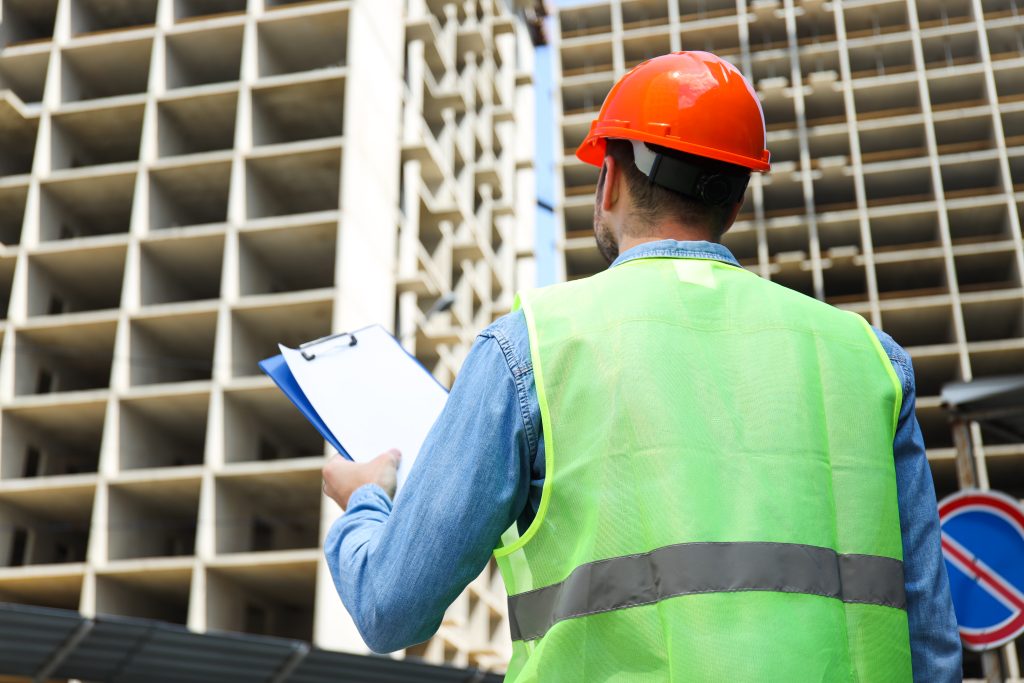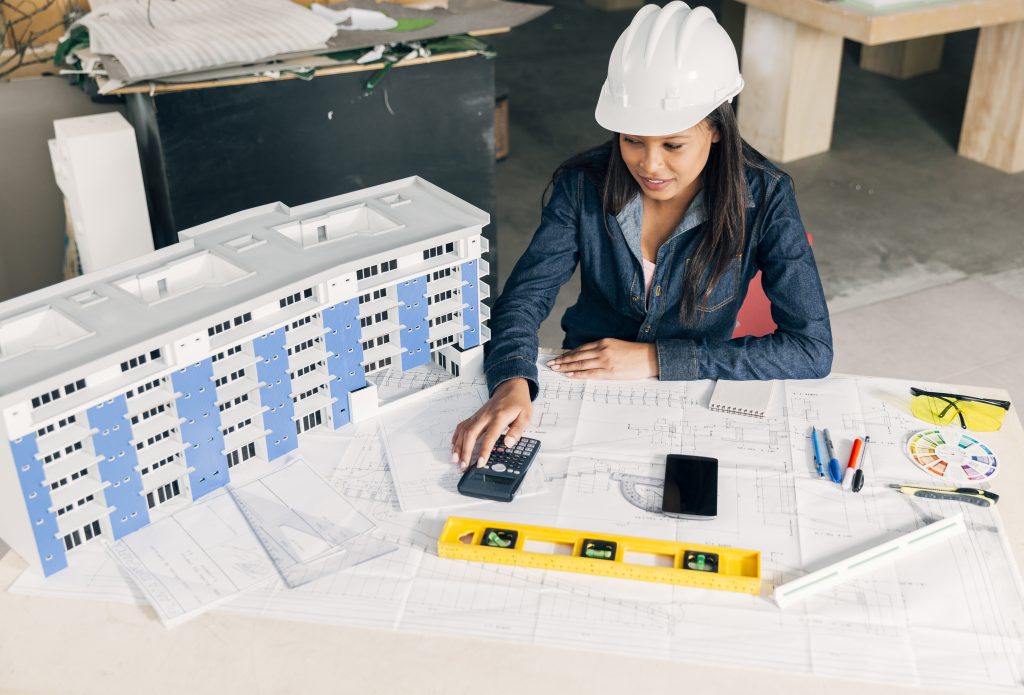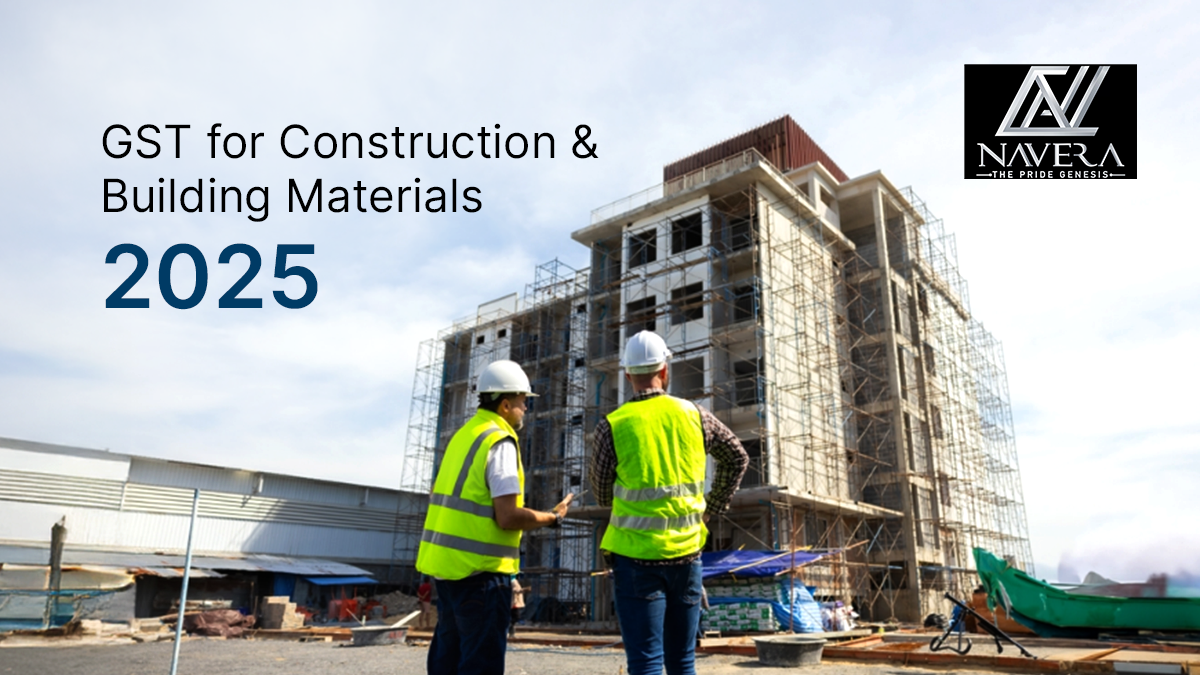- NAVERA BUILDERS PVT LTD
- +91 9207601111
- info@naverabuilders.com
GST Rate for Construction and Building Materials 2025
GST Rate for Construction and Building Materials 2025
The construction sector in India is one of the biggest contributors to the country’s economy and one of the most closely watched under taxation. When GST replaced older taxes like VAT, excise duty, and service tax, it was meant to simplify compliance and make pricing clearer. But, over time, new rules and revisions have kept developers, contractors, and buyers constantly adjusting.
The GST structure for construction keeps shifting every few years. Builders and suppliers are once again adjusting to the new slabs and rules introduced in 2025. These changes affect how materials are priced and how services are billed on-site. Learning about the current GST rates and exemptions can help anyone working on a project avoid confusion and reduce spending.
Applicability of GST in Construction
GST applies to nearly all forms of construction activity in India. It covers the supply of materials, provision of labour and services, and composite contracts between builders and buyers. What it means is that whenever there is a transaction of goods and services, GST comes into play.
However, GST does not apply to completed buildings that have an occupancy certificate. Under-construction properties, on the other hand, are taxable. Before adding GST to a project, builders and contractors have to look at where the work stands. A site that’s still under construction in March 2025 will come under GST. But if the same property gets its occupancy certificate later, maybe around July, then any sale after that won’t be taxed.
GST Rate on Construction and Services (With HSN Codes)
Construction services are classified under HSN code 9954. The rate depends on the type of project and whether the developer or builder claims input tax credit (ITC).
| Type of Construction | GST Rate (2025) | ITC Availability |
| Affordable Housing Projects | 1% | Not Available |
| Residential or Commercial Projects | 12% | Available |
| Composite or Infrastructure Services | 18% | Available |
Earlier, developers often struggled with overlapping categories between works contracts and real estate projects. The revised GST 2.0 slabs aim to simplify classification and minimize disputes. Builders now maintain project-wise invoicing and GST records to keep compliance straightforward. These rates cover most types of construction services under the current systems.
GST on Construction Materials in 2025
The GST on building materials depends on the type of product and its HSN code. The table below highlights the current rates for commonly used materials, including GST on sand, GST on bricks, paint GST rate, steel GST rate, and GST on tiles, among others:
| Material | HSN Code | GST Rate |
| Cement | 2523 | 18% |
| Sand | 2505 | 5% |
| Bricks | 6904 | 12% |
| Steel | 7208 | 18% |
| Granite and Marble | 6802 | 18% |
| Stone | 2516 | 5% |
| Gravel and Aggregates | 2517 | 5% |
| Paints and Coatings | 3208 | 18% |
Most of these rates have remained stable since 2023, though the government continues to review them for better alignment with market realities. Contractors handling both goods and services under a single agreement should also keep in mind the composite supply rule, where GST is calculated based on the main component of the contract.
Factors That Affect GST Applicability on Construction Services

Type of Construction
Rates differ between residential, commercial, and infrastructure projects. Industrial or government contracts usually attract higher GST because they involve large-scale composite supplies.
Nature of the Transaction
When a contract covers both materials and services, it’s treated as a works contract under GST and taxed as a service. Pure supply of materials or labour may be taxed differently or even exempt, depending on how the transaction is structured.
Who is Involved in the Transaction
Developers, contractors, and landowners each handle GST in different ways. A developer selling flats that are still being built pays GST on the total sale amount. However, a contractor working on the project only charges GST for the service work done.
GST Applicability on Construction in India
GST is levied when there’s a taxable supply between two parties. In construction, this usually involves deals between developers, contractors, suppliers, and buyers.
Some types of work get lower rates under government schemes. For example, affordable homes under the PMAY scheme carry just 1% GST without ITC. Commercial, or high-end residential projects, on the other hand, are taxed at 12% and 18%.
When a contractor handles public projects such as schools or other facilities, the rate usually comes to about 12%. Learning about these categories can help you plan better and avoid billing errors. Knowing which GST rates fit your project also keeps compliance straightforward.
GST Exemptions and Concessions
Affordable Housing
Buying a home for the first time already comes with enough costs to track. Homes built under PMAY or similar government-backed schemes come under the 1% GST rate without ITC. The idea behind this lower tax rate is simple, to make housing a little easier to afford for families buying their first home or moving into a mid-income property.
Land Transactions
Selling land or a completed property that already has an occupancy certificate does not attract GST. These transactions are outside the scope of the tax since they are treated as neither goods nor services.
Pure Labour Contracts
Projects that involve only labour, like maintenance, finishing, or renovations, may fall under reduced GST rates. In certain cases, they may even be exempt, depending on the type of job and the terms of the contract.
e-WAY Bills
Anytime construction materials worth more than ₹50,000 are transported, an e-WAY bill is generated. It’s a simple online document that keeps track of goods transported and keeps the supply chain transparent.
Completed Properties
GST no longer applies to the sale or resale of a building, once it’s fully completed and certified. Instead, buyers only pay stamp duty and registration charges. This makes completed properties slightly easier to handle, from a tax perspective.
GST Calculation on an Under-Construction Project (Example)
Let’s consider a flat priced at ₹50 lakh in an under-construction project.
- Service Component: ₹40 lakh
- Material Component: ₹10 lakh
- Applicable GST Rate: 5% (without ITC)
- Total GST = ₹50,00,000 x 5% = ₹2,50,000
* 5% GST is for all homes that don’t come under the affordable housing schemes.
The buyer pays ₹52.5 lakhs in total. If ITC were applicable under a 12% rate, the developer could claim deductions on input materials, but the buyer’s total outflow would stay close to the same. Many buyers overlook whether GST is part of the quoted price. Double-check to prevent any disputes later on.
Availability of ITC on GST Paid for Construction Activities

ITC Availability
Developers can claim ITC on GST paid for inputs such as cement, steel, and professional services, provided the final project is taxable (e.g., under-construction property).
Non-Eligibility for Residential Projects
If a development project already has its completion certificate, developers can’t claim ITC. Since GST doesn’t apply to the final sale, the earlier taxes paid on materials and services stay on as costs for the developers.
Eligible ITC on Works Contract
When developers engage subcontractors for work like plumbing, electricals, or interiors, they can claim ITC on those services if they comply with prescribed documentation and tax filing rules.
Common Challenges in GST for the Construction Sector
- Compliance Complexity: Different tax slabs, rate variations, and HSN codes make GST compliance a real challenge for most contractors.
- Cash Flow Issues: ITC refunds don’t always come on time, and when they don’t, it can put real pressure on liquidity, especially for developers managing several projects at once.
- Frequent Changes: GST rules are revised frequently, so staying updated has become a regular task for construction firms.
- Classification Disputes: Figuring out whether a service counts as composite or pure isn’t straightforward. It leads to disputes or mismatches during filing.
- Refund Delays: Projects with heavy material costs tend to wait longer for refunds. The longer the delay, the greater the impact on projected cash flow.
Maintaining digital records and keeping up with CBIC notifications helps avoid compliance issues.
Wrapping Up
GST has streamlined how construction is taxed in India, replacing a tangle of earlier levies with a one unified system. Like every policy, GST keeps changing over time. Understanding which rates apply, where exemptions fit, and how ITC works can genuinely help builders and buyers both save time and trust.
As housing and infrastructure projects grow through 2025, keeping track of GST changes isn’t just about staying compliant. It’s also about better financial planning and smarter decision-making.
At Navera Builders, one of the best builders in Thrissur, we make it a point to stay ahead of every regulatory update so our projects remain transparent, compliant, and fair for clients. From managing documentation to optimising tax structures, every step is handled carefully so buyers can focus on what truly matters: building their future with confidence.
FAQs
What are the 18% GST items in construction?
Cement, ceramic tiles, and air conditioners fall under the 18% GST slab. Cement had its GST reduced from 28% to reduce the financial burden for low and middle-income groups.
What is the GST on construction materials?
GST rates differ depending on the material. Cement used to carry the highest GST rate at 28%, but now with the GST 2.0, it has come down to 18%. Steel and paints remain unchanged, with 18% GST. Common materials such as sand, stone, bricks, and stones usually carry a 5% GST. The rates may differ slightly depending on updates and notifications from the GST council.
How to calculate GST on the construction of a residential building?
Multiply the project value by the applicable GST rate, usually 5% or 12%, based on eligibility.
What is the GST rate for civil construction?
The standard rate for civil construction is about 18%. Some government-backed housing schemes qualify for a GST concession, reducing the rate to a lower slab.
Is GST applicable to ready-to-move-in flats?
Once a flat receives its occupancy certificates, GST is no longer applicable. Buyers are only responsible for the stamp duty and registration fees.




